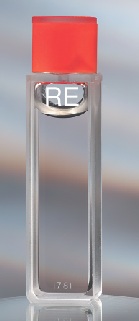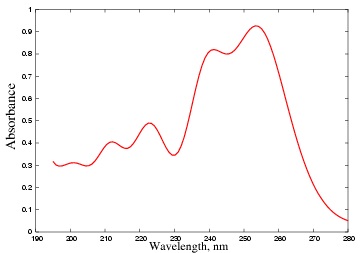
For assessing wavelength accuracy of UV spectrophotometers

| Description | Rare Earth sulfate (0.05%) in sulfuric acid (0.03%) sealed in a quartz cell |
|---|---|
| Primary Usage | Validate the Far UV scale of spectrophotometers |
| Useable Range | 200nm to 260nm, spectral bandpass of 3nm or less |
| Physical Configuration | Far UV quartz cell that has been permanently sealed by heat fusion |
| NIST Traceability | Each set is supplied with a Certificate of Analysis and NIST Traceability |
| ISO Accredited | Accredited by UKAS ISO 17025, ISO Guide34 and ISO 9001 |
Product Description
View/Download Comprehensive Data Sheet for Cerium Oxide Rare Earth Reference
The validation of the wavelength scale in the Far UV is difficult because of the lack of suitable reference materials. Starna has developed the new Rare Earth reference material which allows you to validate the wavelength scale down to 200nm. The reference consists of a solution of the Rare Earth material dissolved in an aqueous solution of very dilute sulfuric acid which has been permanently heat sealed into a high quality quartz cuvette. The use of the filled quartz cell assures that the optical configuration for your quality control is exactly the same as for a normal analysis. Each reference set is supplied with a NIST Traceable certificate which lists the expected wavelength of each of five peaks and the confidence limit of the analysis.
| Far UV Peaks: |
|---|
| 201 nm |
| 212 nm |
| 223 nm |
| 240 nm |
| 253 nm |
Suggestions for Use
This reference presents a wide range of resolvable peaks which are easy to correlate with the wavelength indicator on your spectrophotometer. The first procedure should be to scan the Rare Earth reference cell over the useable range to assure that all of the peaks can be resolved. Alter the slit width and scan rate to produce a useable spectra. Check each peak to assure that the reading on your spectrophotometer is within the manufacturer's tolerances for the wavelength of your spectrophotometer. If not, get a service technician to check and, if necessary, adjust your instrument. The Rare Earth reference is measured against an air blank.
Periodically check the spectra. The periodic use of your Rare Earth cell will build a log of your instrument's wavelength accuracy for use with certification and troubleshooting should the correlation change over time.
Absorbance Scan of Rare Earth

Interpertation of Results
Compare the wavelength peaks from your instrument with the expected values on the certificate supplied with the reference set. If the readings are within the expected range for your instrument then your wavelength scale is correct. If not, consult your service techincian and have the instrument evaluated.
Quality program
Each time that the analysis is repeated you can compare the new results with the previous results to check for any variance. If your instrument needs service because of a change in resolution, the historical data will greatly assist the service technician.
How to Order
| Catalog Number | Description |
|---|---|
| RM-RE | Far UV Wavelength Reference Reference, NIST traceable and ISO 17025 |
Download MSDS Sheet for RM-RE Reference